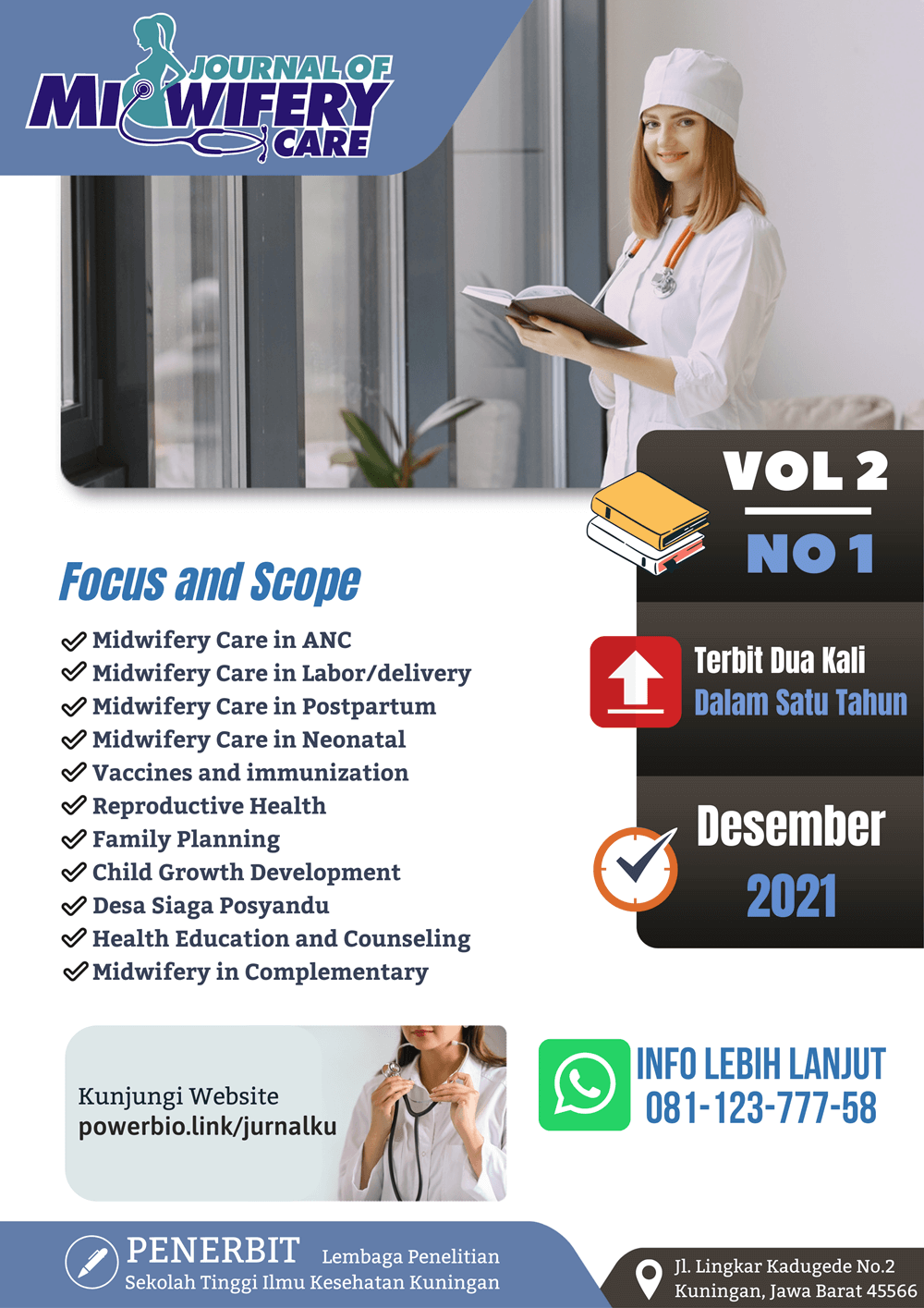FAKTOR-FAKTOR YANG BERHUBUNGAN DENGAN PENGETAHUAN KADER POSYANDU TENTANG GOLDEN PERIOD PADA ANAK BATITA DI POSYANDU DESA GARAJATI KECAMATAN CIWARU 2021
DOI:
https://doi.org/10.34305/jmc.v2i01.352Keywords:
Golden Period, Kader Posyandu, Pendidikan, Usia, Sumber Informasi, PengetahuanAbstract
Golden Period adalah masa disaat otak bayi mengalami perkembangan yang paling cepat. Kader sebagai salah satu ujung tombak kesehatan masyarakat di Desa bertugas menjadi jembatan antara masyarakat dengan petugas kesehatan, harus memiliki pengetahuan tentang kesehatan salah satunya tentang Golden Period pada tumbuh kembang anak batita. Hasil studi pendahuluan dari 5 orang kader terdapat 3 orang yang belum mendapat informasi khusus tentang golden period, 2 kader berpendidikan SMP dan 1 orang berpendidikan SMA yang semuanya berusia lebih dari 35 tahun. Tujuan penelitian ini untuk mengidentifikasi faktor-faktor yang berhubungan dengan pengetahuan kader tentang golden period.
Jenis penelitian yang digunakan adalah analitik desain korelasional. Populasi penelitian ini adalah semua kader posyandu Desa Garajati sebanyak 30 orang dengan teknik total sampling, instrument yang digunakan adalah kuesioner. Rancangan analisis data yang digunakan adalah analisis univariat dan analisis bivariat dengan uji statistik rank spearman.
Kader sebagian besar berpendidikan SLTA/SMA 16 orang (53,3%), sebagian besar kader berusia diatas 35 tahun 24 orang (80,0%), sebagian besar kader mendapatkan informasi dari media elektronik sebanyak 19 orang (63,3%), Hasil penelitian ini terdapat hubungan antara pendidikan dengan pengetahuan kader dengan nilai koefisien korelasi 0,692. Tidak terdapat hubungan antara usia dengan pengetahuan karena nilai koefisien korelasi 0,102 yang berarti tidak ada korelasi antara usia dan pengetahuan. Terdapat hubungan antara sumber informasi dengan pengetahuan kader posyandu dengan nilai koefisien korelasi 0,396.
Kader Posyandu diharapkan lebih antusias dalam mencari informasi tentang Golden Period pada tumbuh kembang anak batita sehingga dapat meningkatkan pengetahuan kader tentang golden period pada anak batita.
The Golden Period is the time when the baby's brain develops the fastest. Cadres as one of the spearheads of public health in the village are tasked with being a bridge between the community and health workers, they must have knowledge about health, one of which is about the Golden Period on the growth and development of toddlers. The results of the preliminary study of 5 cadres, there are 3 people who have not received special information about the golden period, 2 cadres with junior high school education and 1 person with high school education, all of whom are more than 35 years old. The purpose of this study was to identify factors related to the knowledge of cadres about the golden period. The type of research used is correlational design analytic. The population of this study were all posyandu cadres of Garajati Village as many as 30 people with total sampling technique, the instrument used was a questionnaire. The data analysis design used was univariate analysis and bivariate analysis with Spearman rank statistical test. Most cadres have high school/high school education 16 people (53.3%), most cadres over 35 years old 24 people (80.0%), most cadres get information from electronic media as many as 19 people (63.3%), The results of this study there is a relationship between education and knowledge of cadres with a correlation coefficient of 0.692. There is no relationship between age and knowledge because the correlation coefficient value is 0.102, which means there is no correlation between age and knowledge. There is a relationship between the source of information and knowledge of posyandu cadres with a correlation coefficient of 0.396. Posyandu cadres are expected to be more enthusiastic in seeking information about the Golden Period in toddlers' growth and development so that they can increase cadres' knowledge about the golden period in toddlers.Downloads
Published
How to Cite
Issue
Section
License

This work is licensed under a Creative Commons Attribution-NonCommercial-ShareAlike 4.0 International License.
Journal of Midwifery Care published under the terms of a Creative Commons Attribution 4.0 International License / CC BY 4.0 This license permits anyone to copy and redistribute this material in any form or format, compose, modify, and make derivative works of this material for any purpose, including commercial purposes, so long as they include credit to the Author of the original work.
This work is licensed under a Creative Commons Attribution 4.0 International License / CC BY 4.0






